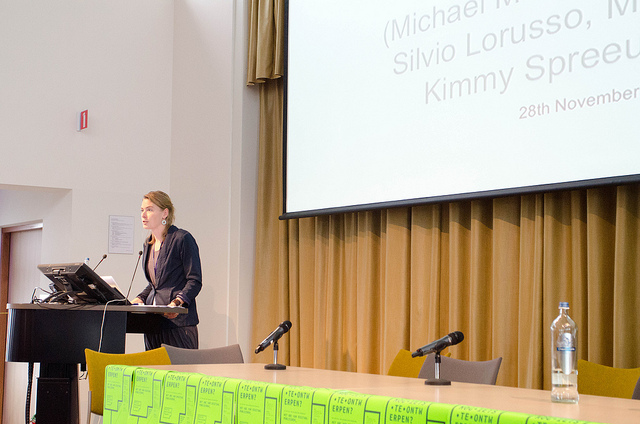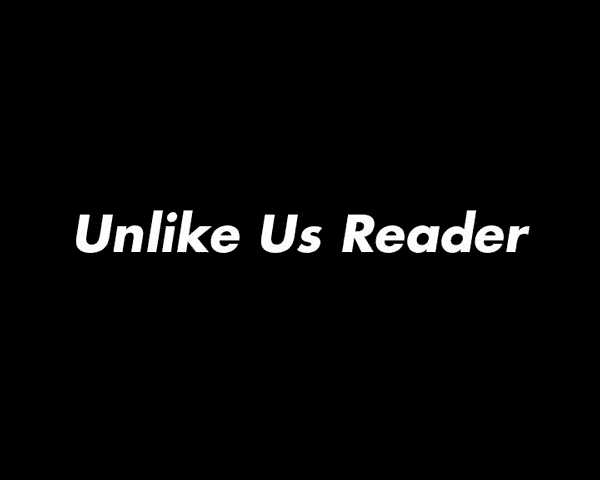The final presentation of the Digital Publishing Toolkit meeting, the ABC of digital publishing, was held by Miriam Rasch, publication manager at the Institute of Network Cultures. In her talk, she addressed workflows, format conversion, finding the ideal format, metadata and how to put these all together. According to Rasch, the great diversity of input and output formats that are available today, calls for digital publishers to have a flexible workflow, instead of a single defined path to follow.

Miriam Rasch, Photo: Martin Risseeuw
Taking the Silvio Lorusso’s idea of the ‘Book as a Directory‘ as starting point, the main goal of the INC subgroup (consisting of Michael Murtaugh, Joost Kircz, Silvio Lorusso, Miriam Rasch and Kimmy Spreeuwenberg) is to define the workflow for INC publications. In doing so, the aim is to make it easier for everyone involved (editors, designer and INC staff) to ‘natively’ output digital publications, as well as to provide insights about digital publication workflows, which can be useful for publishing houses.
Considering the fact that Adobe InDesign is still central to the workflow of many publishers, INC’s experiments with new publication forms started with by applying an Indesign-Centric Workflow to the development of the Epub version of the Unlike Us Reader print publication. (Read elaborate notes on the conversion here). This process actually turned out to be quite sloppy with a lot of manual labour, e.g. adding hyperlinks. Consequentially, INC realized that it would be much more effective to have a modified HTML centric workflow, with structured content in each phase and a file format that is maintained throughout the entire process.

Html Centric Workflow, INC Subgroup
This file format should then easily serve as the basis for a printed publication as well as an epub. But, how is this possible with many authors submitting their work in a Word file?
One solution, albeit not the holy grail, is to use MarkDown, a rather simple markup language, comparable to HTML. According to Rasch MarkDown is perfect for text -based editors, like herself, and at the same time very suitable for making digital products. It has a great level of readability, while maintaining a strict content structure. Then again, most authors will keep working with Word instead of Markdown editors like Mou. Therefore Rasch stressed the need for ways to convert Word documents to the Markdown format. INC´s research into file formats and conversions is documented on the Digtial Publishing Toolkit blog.
The INC subgroup has also started to develop a specific INC set of metadata, which can be useful to manage contents and output custom versions of the publications. They started by referring to a broad Document Type Definition (DTD), similar to that of Elsevier, but eventually derived the metadata directly from all the available content. Compiling a condensed list of about 10-20 metadata that specifically refer to INC readers, was helpful in understanding the essential and wanted metadata for INC´s digital publications, and to figure out what´s ´special´ about the list of INC publications (for example, the various inputs, like video, blogs, interviews, texts etc). The set of metadata is applicable to other publications, but could also prove useful for publishers in general.

INC, condensed metadata set
In addition to this list, INC has considered the idea of embedding metadata directly into MarkDown documents. In this line of thought, Michael and Silvio created a mockup of a customized Markdown editor. But should filing and tagging articles accordingly with the metadata be ´the end´? Are there other unexplored possibilities?
Rasch explained how the subgroup´s research is shifting away from the middle of the workflow to it´s very beginning. It´s the collaborative, back and forth process, between author, editor, designer and proof reader, that marks the publishing workflow. Word could be considered as ´the battlefield´, where many revisions leads to more comments, annotations and corrections. To map the complexities in the workflows, INC has started to take more role-oriented perspective, leading to new questions, such as: how to handle editing in Markdown? Should everyone involved in the workflow start using Markdown editors? These are the kinds of questions the subgroup will increasingly focus on.
Some team members recently participated in the Free Libraries For Every Soul hackathon at IMPAKT where some ideas were developed around epub and the creating new kinds of publications. One outcome was an epub generated out of INC´s Flickr feed. In the future this kind of event-related content could be merged into customized versions of publications, such as an author page, where one could find all of the available related material (biography, writings for the reader, presentation video´s from Vimeo, Flickr Photo´s, related blogposts).
Another concept -at the end of the workflow- was to take the idea the epub format as input to an extreme, and apply it to relatively new genre, the ´book trailer´. This resulted in the creation of the epub Book Trailer Generator, which manipulates a publication´s metadata with scripts, to generate a ´subliminal´ book GIF trailer.

Unlike Us Reader Epub Trailer
Do you have feedback, comments or questions regarding the Digital Publishing Toolkit research project? Let us know!*
The original presentation file (PDF) can be found here
Watch the full presentation below
Showcase Institute of Network Cultures – One thousand and One workflows from network cultures on Vimeo.


